#german labour front
Text
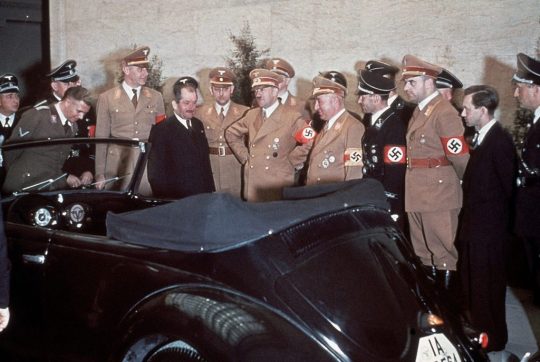
Doctor Ferdinand Porsche (in suit), Adolf Hitler and, immediately on Hitler’s left, the head of the DAF (Deutsche Arbeitsfront/German Labour Front), Doctor Robert Ley, admiring Hitler’s birthday gift on his 50th birthday: a convertible Volkswagen, 20.4.1939. Note the Berlin number plate (1A)
#germany#ww2#nazi germany#nazi party#DAF#adolf hitler#robert ley#ferdinand porsche#vw#vw beetle#1939#german labour front#deutsche arbeitsfront#nsdap
10 notes
·
View notes
Text

♪ — 𝗥𝗘𝗔𝗗 𝗧𝗛𝗘 𝗙𝗟𝗢𝗪𝗘𝗥𝗦
sebastian vetteln x fem! italian! reader (fluff)
“. . . in whixh neither iof you speak the smae language, but can still understand each other through petals. you might not speak german and he not italian, but who can't speak flower?”

( master list | more of sebastian vettel ) ( requests | taglist )

Seb closed his eyes, freezing in his spot. he felt you gently brush his hair from in front of his face and clip the locks with the rest of his hair on his head.
When he opened his eyes again he couldn't look away from you, watching you brush the rest of his golden locks behind his ear gently. "Sembri così carino." [you look so cute] you giggled once you looked at the finished result. Sebastian vettel in a red apron holding a the batch of soil that still held the shape of the pot from which it was recently removed, with his hair pinned to the top his head with a hello kitty hair clip leaving his forehead exposed,
"danke." he mumbled with a little nod, trying to supress a smile which only resulted in an upside down smile. The blond didnt even realize he was staring, watching you go back to tending the garden until his mom jolted him out of his trance.
Spring was coming and your aunt decided to invite the her friend next door for a brief exchange of soil since she had extra and Heike Vettel could work a little on her own garden as well. This is where things get fluffy.
It was the moment Sebastian heard his mom mention the house across did his brain turn into mush and heart beat in rush.
the poor boys thoughts got up tangled up he swore he could hear his mom calling him to go with her because he was already putting his shoes on. And he did end up going with her because what kind of mom would Heike be to look her son in his big gorgeous blue eyes when he's all joyful and and say no?
"Es ist eine Überraschung, dich zu sehen, Sebastian." [a surprise to see you, sebastian] he greeted the middle aged woman back polietly as the two women went off to the kitchen. Slipping his shoes off, the blond went to follow when his eyes caught motion outside the back glass doors.
You're here. Now Seb's heart was truly pacing, seeing the sight of you gave him a sense of relief and anxiety. The italian girl that comes and spends the spring with her aunt every spring, thats what Sebastian knew you as. Every spring, once a year since he was a kid, you'd come over.
He remembers swinging at a park when he was 10 with his friends when he only really went there because he knew you'd be there riding your bike that day. Or that time he was 14 and instead of working on his kart inside the garage he worked in front because he wanted to impress you when you walked by.
Now that he was 19, he should probably do something about it. but the gust of the anxiety in his blood wasn't letting him, so he just stood by the sliding door a watched as you gently tend to the growing garden, removing plants from the pots and adding them in the raised bed.
Seb thought you looked beautiful and elegant, tending to nature and decorating the little garden despite it not being that big or having much to work with. And when you noticed him and called for help ( he assumed since he didn't speak italian and didn't understand your instructions ), Seb found himself in the apron, helping you preen flowers or add them to bed or pots or decorate little corners with stones.
This was fun. And what his mother found funny was the fact that his nature as a driver makes seb constantly keeps his hands clean - which is the total opposite of the situation he's in at the moment, fingers all dirty with soil stuck under his fingernails.
"Sebastian!" The blond jolted, looking back at his mom who couldn't help but laugh at his appearance. She left him out of his sight for 40 minutes and finds him barefoot and admist labour, holding a little pink carnation with his bangs held up with a hello kitty clip.
If it was any other woman, the blond would've ripped the clip out, washed his hands and feet and walked right out with his mom. If it were any woman he wouldn't even be helping her garden or letting her touch his hair. But this was you, the nice and kind and graceful- he could go on, but the point is that Seb found himself lucky- blessed even that you went out of your way to make sure that he was comfortable and not hurting his eyes.
Sebastian tried to hide the embarrassment looking away. He wasn't supposed to look so . . . whatever softie he looks like right now. "lass uns gehen." [lets go] his mom waved, tried to hold in her giggles. "Nein, nein, verlass ihn, sie haben Spaß." [no no, leave him, they're having fun] your aunt defended, also trying to supress her joy.
Seb huffed, furrowing his eyebrows ready to say something to defend his reputation but the words never left his mouth and his eyebrows uncreased quickly and eyes his eyes softened.
"Prenderò questo, si stresserà se rimane in aria troppo a lungo." [i'll take this one, it'll get stressed if its out in the air too long] whatever you said, seb agreed with you, gently and carefully handing over the pink flower, his hands and fingers brushing against your a few times, which might have been on purpose.
"Komm lass uns gehen. Lassen Sie die Arbeit im Stück." [come on, lets go. leave y/n work in piece] The blond sighed, stepping off the greenery and onto the pavement to hose his legs off as your aunt walked his mom to the door. "fermati di nuovo qualche volta." [stop by again sometime] he didn't even realise you'd walked right up to him. He gave you a little smile, still having no idea what you were saying but understanding your intentions.
if Sebastian could blush anymore than he already was, he would. You putting a little flower on his ear did it for him, and the smile you had as well as you waved before getting back to work.
Sebastian couldn't erase the smile of his face, looking at the flower in his room all giddy like a girl in a romcom. He went to dinner and back, sitting at his desk and admiring the plant. It was a while before he realized something.
FLOWERS HAVE MEANINGS! Seb remembers seeing a book with the title having the word that looks language. LANGUAGE OF FLOWERS!!
If Haike vettel didn't know something was up, she did now. "Wohin gehst du?" [where are you going] she asked, standing in the kitchen to ready dinner. "der Bibliothek." [the library] Seb answered as he ran jumped down the stairs and jumped into his shoes, shouting a bye before shutting the door after him.
★ ☆ ━━━━━━━━━━━━━━━━━━━━
"ähm … Hallo." [uhm, hi] The blond greeted shyly once you opened the door. You greeted him with a smile and a 'ciao'. The feeling of seeing your eyes light up once he held up the pot with the purple flowers. Morning glory was the flower. 'affection' was the meaning, to reply to your 'you're lovely'
"sono adorabili." [they're lovely] you smiled widely taking them politely once he held them out for you, leaning in to smell a flower from the bunch. Sweet. it took you a second before it clicked in your head. The blush and bashful smile told Seb what he needed.
that was the first time seb gave you flowers, and definitely not the last. You received them often, even when you're in italy. the boy never seized to surprise you. it started off simple like blue salvia (thinking of you) up till pink Camilla (longing for you). Seb remembers that pink Camilla day very well, the 2008 Italian grand prix.
He made a call to the florist near you Friday night before and spent the morning worrying if you received the flowers or even understood them. He remembers sitting in his torro rosso on Sunday morning, playing with the hello kitty hair clip you gave him the year prior, fidgeting with it as it sat on his fireproof sleeve from under his race suit so he could sneakily wear it throughout the grand prix and maybe get a little luck to win the race he was starting from pole, in front of all the other hungry sharks.
his favourite part about that weekend was winning the grand Prix with you watching, kissing the camera which he wished was you. He won your home grand prix, what possible flower could be waiting for him when he gets home?
★ ☆ ━━━━━━━━━━━━━━━━━━━━
Despite already moving out from his parents home by at this point in his formula one, Sebastian still went back. Spring was on its way and so were you.
You remember this day very well, you hadn't even finished unpacking when the doorbell rang. You didn't even have to check to see who it was, you were already running down the stairs and pulling the door open. Yours eyes lit up upon seeing the blue eyed blond, a giggle falling from your mouth as you stepped aside to let him in.
as he stepped inside, Sebastian pulled the small packet of seeds from behind his back. Yellow tulips. The way your smile light up your face as you excitedly pulled him to the garden before he could take his other shoe off.
Seb wansn't sure if he picked the right flower. he's been standing at the local florist for an hour or so with his now little own language and archive of flowers book, trying to find the correct flower.
theres sunshine in your smile , desperate love , hopeless love
sebastian sighed internally, watching you walk around the garden in progress. He put a smile when you returned. You held out your hands for him, and he complied letting you give him the jonquil.
returned affection , love me , desire
★ ☆ ━━━━━━━━━━━��━━━━━━━━
"Ciaaaaao." You called out through the the flower shop once you heard the entrance door ding. You stepped out from behind the counter, feeling the whole room light up at the sight of your blond, hiding his face a boquet of tulips.
"Seb!" you giggled stepping towards him making the boy peak from behind the petals, a wide smile on his face. he giggled happily lowering the bouquet, welcoming you in a hug. red tulips? you thought, squeezing him in the hug briefly before pulling away and pressing a kiss to his cheek.
declaration of love
★ ☆ ━━━━━━━━━━━━━━━━━━━━
"Y/N," Sebastian called gently, making you peel your eyes away from the stand of fruits in the busy farmers market. You looked to your husband eho had an exited smile holding something behind his back.
"what are you hiding?" you scolded, trying to see, only to be met by a gorgeous a pot of jasmine. "Sebastian," you scolded, making the grown man pout. "What are we going to do with a jasmine tree? We have a whole meadow at home."
"Read the flowers," Seb scolded back playfully, nudging you. he'd think that after 12 years of marrige youd still have all the meanings memorized.
unconditional and eternal love
"i think the bees will like these peaches, can you get me strawberries for the bumble bees? potted ones." "or we could just grow them." Sebastian countered as he walked away only to be pulled back gently.
He smiled widely upon seeing you gently tuck a forget-me-not and a primrose in his hair above his ear. "very well then." the blondie kissed your cheek before going to get the things you asked for.
eternal love , true love , i cant live without you

#‧˚⊹🪴 ଓ :: 𝗺𝘆 𝘄𝗼𝗿𝗸𝘀 ‧₊˚⤾#SV5#rbr!seb#Sv5 x reader#rbr!seb x reader#sebastian vettel x you#sebastian vettel x reader#red bull sebastian vettel#sebastian vettel oneshot#sebastian vettel fanfic#sebastian vettel fluff#sebastian vettel imagine#formula 1#formula racing#f1#h f1 fanfic#f1 x you#f1 x reader#f1 imagine#f1 fluff#f1 fics#formula one x you#formula one x reader#formula one x y/n#young!seb
337 notes
·
View notes
Text
Chase
It was one of the oldest games: chase. The Toymaker had described the rules of play with great satisfaction. "You run, and I…," he lingered, enjoying the sound of the words, "…catch you."
You felt your face grow warm. You lifted your chin, defiant. "Do I get a head start?"
The Toymaker tapped a finger to his lips. He nodded sagely. "Three."
"Three? Three what? Three minutes? Three doors?"
The Toymaker smirked. "Two," he said. You caught on, wide-eyed. You scrambled for the workshop door just as behind you, the Toymaker chimed "One-!"
You slammed the door, back flat against it.
There was a knock at the door, close to your ear - the classic shave-and-a-haircut rhythm. The doorknob began to turn. Okay. Okay. Run? Run.
You threw yourself forward and fell into the first door in front of you. Then another, and another, sticking with forwards, forwards, forwards.
Four corridors down, you stopped and looked around. Endless doors ran either side of your left, and endless doors stretched on for infinity to your right. Okay. Pick one. It didn't matter which.
You opened a door. It shut behind you. You opened another. And another, weaving and choosing at random, each time ending up in a corridor identical to the one you had left. You ran back and forth, choosing left and right, forwards and backwards at random hoping to confuse and put as much distance between you and your pursuer as possible.
Even if the thought of getting caught did give you a secret little thrill.
"You can't hide from me-ee~" The Toymaker's voice rang out, clear as day, through the corridor. You dived through the next four, five, six doors, sometimes choosing left, sometimes choosing right. No matter which way you weaved, you knew that, somewhere, somehow, he followed. You knew this game could last forever; you knew he wanted it to. The Toymaker was patient. He had all the time in the world. And this one was a favourite of his. There was something traditionally indulgent about a game of chase, as he'd told you: the hunter and the hunted, the cat and the mouse. The suspense. The thrill.
You couldn't help it. You had to stop and give yourself a minute to catch your breath. You closed your eyes, taking slow breaths in through your nose and out through your mouth. Your breathing was becoming less laboured when you felt breath tickle your ear.
"Boo."
You let out a yelp and opened your eyes. There was no one there. Still, not ready to take any chances, you hurried on into the maze. Door door door, left right left left left right left. You opened the next door--
--and ran smack into the Toymaker.
You bounced off his chest, stumbling back-- and he caught you by the arm, drawing you back in. He was smiling, full of mischief and delight. "Meine kleine Liebling, how much fun you make for me!" he said, as his other hand finding and tapping a rhymth at your waist.
You couldn't help it. You giggled. You clapped a hand to your mouth and took a quick step back. The Toymaker raised his eyebrows.
"Fraulein, are you tickle-ish?"
"No," you said, far too quickly. The Toymaker was not convinced. He smiled, cat-like, and took a step towards you.
"Oh, but I zink you are ly-ing," he chimed. His hands were out, fingers wiggling. Nervous laughter bubbled inexorably up out of you; you cursed silently at your body's betrayal. You twisted, ready to run again, but gentle hands caught one of your own. You turned, and the Toymaker smiled with such innocence as he touched his fingertips to the palm of your hand. He drew a swirl with a leisurely touch. You pursed your lips, determined, refusing to break eye contact with him. He winked, and his fingertips slid up over the soft skin of your inner wrist. You bit your lip, smiling. Then he walked his fingers up your arm to your shoulder, travelling along your collar and up your neck--
You couldn't fight it any longer - you giggled, squirming at the delicate touch to sensitive skin.
"Oh," he said, and the German delight was gone, replaced with mischief, "someone's in trouble now."
A scream of laughter split the corridor as the Toymaker pounced.
You never stood a chance.
106 notes
·
View notes
Photo

On this day, 28 April 1909, biracial Black German anti-Nazi labour organiser and actor Hilarius Gilges was born in a working class household in Düsseldorf, Germany. In 1926 he joined the Young Communist League of Germany (KJVD), and a few years later he founded a radical worker entertainment group called the Northwest Ran. Northwest Ran put on working class plays, music and other entertainment, as well as organising anti-fascist protests. After a conflict with racists and police at a demonstration, Gilges was arrested and jailed for one year. Despite this, he continued his activism, and travelled through many towns and villages attempting to mobilise opposition to Nazism. After the Nazi takeover, in June 1933, he was abducted from his apartment in front of his family by a dozen SS officers. His body was soon found in the River Rhine, with 37 stab wounds and a bullet wound to the head. One of his daughters, Franziska Helmuss, later recalled: "His funeral was well attended, but exclusively by women. The men were too afraid to be associated with him. The stonemason who made the gravestone for my father was incarcerated for five years in a Nazi concentration camp." Despite some of his killers being known, none of them were punished after the war. A plaza in Düsseldorf by his apartment was named after him in 2003. More information, sources and map: https://stories.workingclasshistory.com/article/9972/hilarius-gilges-born https://www.facebook.com/photo.php?fbid=616808703825682&set=a.602588028581083&type=3
244 notes
·
View notes
Note
are the outfits in VDtWOF inspired by anything in particular or generic in a way?
Thank you for the ask! I love getting these :p
I had the opportunity to borrow a historian's rare book on 14th century bohemian clothing after he heavily criticized the last game I had a big hand in, Rhythm of Triverz, for period inaccuracies. That gave me a convenient ceiling for the most advanced gowns and armour you could expect in the region at the time. Resources on this are extant online but many don't cite their sources and most good ones are maintained on individual german historians' websites, so I need to do more research on this in general, but here are my basic rules for designing their clothes:
Everyone wears long gowns. Hose were pretty rare in this period. Women might have slightly longer dresses
Everyone wears a plain "shift," a garment that's worn under the main article of clothing. This is the one that gets washed
Garments, even rich ones, are unicolour. Mixed fabrics and colours appear later.
There's very little embroidery or detailwork on regular clothing
A garment will be worn with a belt, which might be longer the higher a person's status, and a pouch carrying an eating knife and other personal items
Most people will wear a head covering. Married women will always cover their hair outdoors, other women might do so too, and all women and girls cover their hair in church. Most common hats should be bundhauben or gugel.
A garment can be worn with a contrasting cloak (blue/red is a common one)
Jewellery is occasionally ok, but no piercings (?)
Shoes as we know them are more 14th/15 century; no big boots. Most shoes will be more like pointed leather socks or for ladies silk slippers. Poor people might wear wooden clogs.
No or very few fancy cuts. Later on you see tunics and gugel with with triangular or even fancier hems; This possibly exists very rarely in a limited capacity on things like a noblewoman's 'Kruseler' veil at this time, but that's probably it.
No black. No one depicted in this comic would be rich enough to waste money on black dye. Nuns and so on wear undyed or brown wool.
Military clothing is more "primitive" than might be expected. Not really any fancy visor helmets or big articulated suits of armour yet, most men-at-arms and even knights wear a mail shirt and a surcoat
As I understand, and I'm more than happy to be corrected on any of this, this applies almost universally. Peasants working in the field will wear dyed colourful garments, not plain rags. If it's hot, you don't take the outer garment off, you tuck the front hem of it in your belt to expose the shift. Masons will climb ladders and haul stone in this stuff. Some labourers or craftspeople will wear an apron and other specialized clothing like a toolbelt, too.

Note how Vesna wears a plain linen shift under her nicer yellow dress. I usually draw her with the sleeves all the way at the wrist, which would be the appropriate way to wear them, but she has it folded back here to make the composition nicer.


Bonus: Amusing pictures of King Václav IV slaying (150 years after when Vesna is set) and the "work uniform" of a bathhouse maid
29 notes
·
View notes
Text
Salaspils: A Soviet Memorial To Nazi Victims In Latvia
Eighteen kilometres out of Riga, a series of stone giants stand frozen in a forest clearing to mark a place that some would rather forget.


The forested approach to the Salaspils Memorial.
The road to the Salaspils Memorial Ensemble stops near the rail tracks, and visitors must walk the final stretch – through forests of pine, and birch that in autumn explodes into canopies of red and gold, the sunlight slicing sideways between trunks that shed their crisp white bark like snakeskin.

The gallery building measuring 100 metres long by 12.5 metres high.
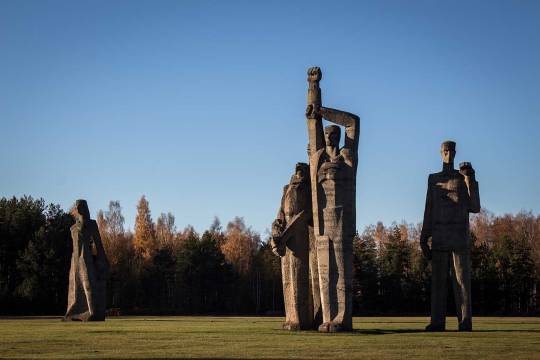
In the clearing beyond stands the Salaspils Memorial Ensemble.
The forest feels alive, almost supernaturally so, making it all the more abrupt to find the path suddenly barred by a looming concrete crossbeam, 100 metres long and more than 12 metres tall. This concrete barrier is a visitor building, an abstract Brutalist gallery that marks the symbolic threshold between life and death. It stands in the place where once there was a guardhouse ringed in barbed wire, the entrance to a former Nazi labour camp that operated for four years here amidst the picturesque Baltic birch. Through the arch, a clearing opens up between the trees; the camp barracks long gone, to be replaced by angular Soviet forms, towering, blocky figures stood as tall as the trees that surround them.
Above the entrance, a Latvian slogan is spelled out on the concrete flank of the gallery “Beyond these gates the land groans”, a line from a poem, written by a former prisoner of this place.

Part of the original wall of Camp Kurtenhof.
SS-Sturmbannführer Rudolf Lange, who was appointed in 1941 a commander of both the Nazi Security Service and the Security Police for occupied Latvia, that same year proposed the creation of a detention facility in the region. It was named Camp Kurtenhof, from the German name for the town of Salaspils, and located for convenience just off the main rail track between Latvia’s two largest cities: Riga and Daugavpils. It was designated a Police Prison and Labour Correctional Camp.

A symbolic tally etched into the gallery building counts time inside the prison.
Work on the camp began in late 1941, and it was built largely by the hands of Jewish prisoners deported from occupied Germany, Austria and Czechoslovakia. At least a thousand Jews were transported from the Riga Ghetto to join the construction team in January 1942. Offered little in the way of comfort, nutrition or sanitary facilities, they were overworked and many would die to that first harsh Baltic winter.

Symbols of Soviet defiance raised on the grounds of the former camp.
These workers were amongst the only Jews to ever set foot in the Salaspils camp. Unlike the Reich’s concentration camps, which answered to their own central administration in Berlin, the Police Prison Camp at Salaspils was under the direct control of local Security Police Commander Rudolf Lange. Its inmates were political prisoners and Baltic dissidents, expanding in summer 1942 to provide ‘labour correction’ to those caught avoiding work regulations; and from 1943 the camp began taking in Baltic police officers and military personnel convicted in SS courts. The Salaspils camp also operated as an intermediary transit camp for prisoners being transported from Belarus and Russia, to forced labour projects in Germany. A large number of children were imprisoned at the camp too, allegedly in dedicated children’s barracks.
youtube
By the later part of 1942 the camp consisted of 15 barracks that between them housed 1,800 prisoners. By summer 1943, there were 30 barracks. Prisoners here were involved in the digging and processing of peat, and according to survivors’ accounts, regardless of its specific ‘Police Prison’ designation, the organisation of work, and treatment of prisoners at Salaspils, was just as brutal as any of the other Nazi camps in the region.

From left to right: Solidarity, The Oath and Red Front.
The official website for the Salaspils Memorial states that, during its years of operation, roughly 23,000 people were imprisoned at the camp. It reports that from May 1942 until September 1944, up to 500 prisoners died of diseases, as many as 150 from exhaustion or brutal punishment regimes, and a further 30 were shot while attempting to escape. The younger prisoners were particularly susceptible to the diseases (such as measles and typhoid fever) that ran rife through the inmate population. It is believed that half the camp’s children died from illness, and after liberation, a mass grave was discovered containing the corpses of 632 children aged 5-9 years old. The Salaspils website suggests that, including the Jewish forced labourers who died during construction, the final death toll of the Salaspils camp stood at more than 3,000 people.

Left: The Unbroken; right: The Mother.
The Salaspils camp was liberated by the Soviets in September 1944. The fences were brought down, the barracks destroyed, but it wasn’t until two decades later that they constructed a grand memorial complex on the site where the camp once stood. A competition was held to select a design for the Salaspils Memorial Ensemble, as it was known, with the winning entry submitted by a team of seven: the architects Gunārs Asaris (who would also create the Monument to the Sailors and Fishermen Lost at Sea, at Liepāja), Oļģerts Ostenbergs, Ivars Strautmanis and Oļegs Zakamennijs, along with the sculptors Levs Bukovskis, Oļegs Skarainis and Jānis Zariņš. The park opened in 1967, and in 1970 its creators would receive the prestigious Lenin Award for their work – in the same ceremony that saw architect Yevgeny Vuchetich awarded for his famous monument at Volgograd: The Motherland Calls.
The opening ceremony was a grand, flower-laden affair, and the Salaspils Memorial Ensemble would go on to be considered one of the most important Soviet memorial sites in the Baltics.

The sculpture called Humiliated.
Today it is not a particularly easy place to visit, and emerging from the trees into the clearing is a sobering moment. The simplicity of these concrete forms invites imagination. Instead of telling you what happened here, this place tries to make you feel it. I found myself reminded of my visit to Auschwitz – a visit I made on a warm summer’s day, birds singing, woodland flowers in bloom. If anything the setting for Salaspils was even more picturesque than that, and I felt a sense of emotional whiplash, after a while, constantly trying to square what I knew about this place with the information my senses were providing me.
The ensemble is built around nine concrete titans (in six installations), who tower over the neat lawns and were said to represent the different types of prisoner kept in the camp. ‘The Unbroken’ lies on his belly, pushing himself up with his last strength. ‘The Mother’ has a look of defiance, standing square to shield the infants that cower by her side. ‘The Humiliated’ kneels, her face partially hidden by an arm raised in a defensive gesture. In the very centre of the lawn, three forms are arranged side-by-side: ‘Solidarity’ shows one prisoner helping another to stand; ‘The Oath’ is a man stood tall stretching his arms into the air; while ‘Red Front’ likely represents a fighter from the paramilitary wing of the German Communist Party – the ‘Rotfrontkämpferbund’ – a group who used the same single-handed fist salute depicted here.

A memorial block where the camp’s gallows once stood.
The Salaspils Memorial features hardly a written word of information but that does not make it a quick place to visit. The monuments that decorate the lawn demand consideration. A single notable script appears on a stone block placed off to the right, between the central figures and the entry gate, marking the location of the former camp gallows. Its inscription in Russian and Latvian reads: “Here humans were executed for being innocent… Here humans were executed for every one of them being a human and loving the Motherland.”

Fragments of the original barrack walls.
At the opposite side of the Road of Death – as the designers named the walking path that circles their concrete giants – a black granite pedestal is designated as the place for laying flowers and memorial wreaths. From somewhere out of sight comes the ticking of a metronome. Intended to suggest life, and the eternal passage of time, the sound is rather like a heartbeat, and lends an uncanny atmosphere to my time amongst the statues.
The old camp buildings may be gone, but here and there, fragments of the outermost walls remain. Some are bare, but others are piled with tributes: plastic angels, Orthodox icons, a selection of sad-looking children’s toys. It feels like an effective memorialisation technique – bulldozing the camp, symbolically destroying its physical legacy, while leaving just enough of its form behind to suggest a historical record of its size and inner geography. Just a year before the Salaspils Memorial opened, the Yugoslav architect Bogdan Bogdanović had accomplished something similar at his Jasenovac Memorial Site, in what is now Croatia: the buildings of the old concentration camp were destroyed, but there, the ground was landscaped into mounds and craters that recorded the location and function of the various different buildings.

Text across the wall of the gallery “Beyond these gates the land groans.”
The only building at Salaspils now is the gallery – entered by an inclined walkway that passes through the length of the imposing concrete arch above the entrance. The space inside is oppressive and claustrophobic, presumably by design. This effect of sensory deprivation allows the visitor time to meditate, perhaps, and process the meaning of the monumental forms outside. When natural light does break through the side walls, it spills in at viewing slots reminiscent of wartime pillboxes. I peer outside, for a panoramic view of the figures on the lawn.
All the while, the sounds of the forest seem amplified as they reverberate though this enclosed space. There is birdsong, the noise of distant dogs barking, and somewhere nearby, where the original tracks cut lines through the trees, the shunting and hissing of cargo trains.

The walkway through the Brutalist gallery building.

The Salaspils Memorial Ensemble, seen from the gallery.
There is something inherently totalitarian about the form of remembrance prescribed by the Salaspils park. The sheer concrete, the lack of information. These twisted human figures tell visitors how they should feel, but the park never provided the tools for a two-way conversation. At Auschwitz visitors are shown piles of shoes, and suitcases, visual triggers designed to encourage an engagement with the numbers. At the National Museum of the Holodomor-Genocide in Kyiv, Ukraine, a similar effect was achieved with grains of corn – arranged in a heaped display where one grain stands for one Ukrainian life lost. Salaspils, in contrast, simply says: these people were punished for loving the Motherland.


Commenting on the Soviet Union’s choice to memorialise Salaspils, Peter Hohenhaus notes how “other, even worse sites of the Holocaust such as Biķernieki received no commemoration at all.” It is perhaps no coincidence though, that the Soviets chose to create such a prestigious memorial over the remains of a camp which had less relation than most to the Jewish Holocaust. (Aside from the construction team, it is reported there were only 12 Jewish prisoners at Salaspils).
Following the war, the Soviet Union severely downplayed the significance of the Holocaust, to present the Soviet citizen, instead, as the chief target of Nazi aggression. Any specific commemoration of the Jewish tragedy was at least discouraged. For example there was a Holocaust memorial built in Minsk, Belarus, named ‘the Pit’; an obelisk on the site where 5,000 prisoners from the nearby Minsk Ghetto were executed by fascists in 1942. Its creators, the stonemason Morduch Sprishen and the poet Haim Maltinsky (who wrote the Yiddish inscription), were both later convicted on charges of Jewish nationalism, and after that, the authorities treated all visitors to the Pit memorial with suspicion. At Babyn Yar meanwhile, a ravine in Kyiv were tens of thousands of Jews were massacred, the victims of the Holocaust are still yet to be recognised with a proper memorial.
The USSR’s post-WWII efforts to ideologically bond its member republics through a shared sense of victimhood, and victory, was felt not least strongly in places like the Baltics – countries who were new Soviet subjects, and uneasy subjects at best. What better place then, for a grand Soviet memorial park, than Salaspils: a police camp that had chiefly housed antifascist Baltic dissidents, and Soviet citizens from Russia and Belarus. It was a place where Latvians and Russians had suffered together, side by side, and of all the dark places left to this region in the wake of Nazi occupation, this was the one whose memorialisation best supported the post-war political narratives of the Soviet Union.
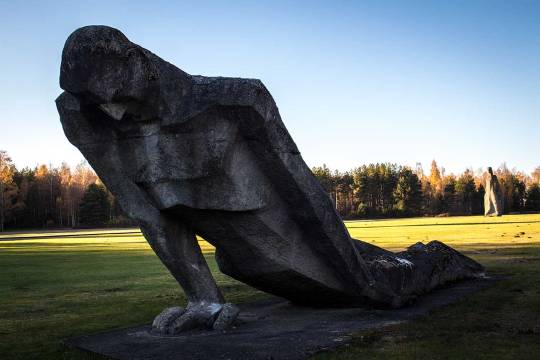
The Salaspils Memorial is recognised as part of the Latvian Culture Canon and in 2017, it was declared a monument of national significance. Despite this recognition however, it doesn’t feel like a place that is cherished, so much as observed. Visitors often report having trouble locating the place, and it hardly seems to be promoted as a tourist destination of note. When compared to videos showing the park’s opening ceremony (crowds of people, neatly trimmed lawns, and the forest pruned back around them), Salaspils today appears somewhat lonely and dishevelled.
Contemporary additions and modifications to the park have seemingly challenged the innate Sovietness of the place. A cemetery for German POWs was added in 2008, adjacent to the main memorial grounds. More recent is the installation of the Salaspils Memorial Exposition. Housed inside the Brutalist gallery building, the collection has been open to visitors since February 2018, and features information and video clips available in Latvian, German, English and Russian.
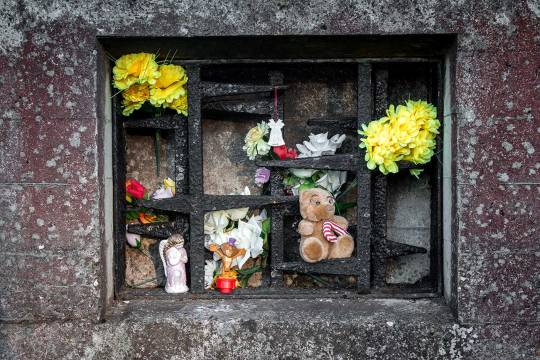

Tributes left by visitors to the Salaspils Memorial.
Elsewhere around the park, and dotted along the ‘Road of Death,’ new information panels have been installed to give context to the park’s otherwise sparse concrete symbolism. The memorial architecture of the park tells the story of Soviet people who fell victim to the Nazis. It is somewhat jarring then, to read contemporary panels that describe both Nazi Germany and the Soviet Union as “occupying regimes.” This is, of course, how the Latvians officially remember that portion of their history: as a violent occupation by a foreign power that would maintain a political and cultural stranglehold over Latvia for the next 45 years. If it seems strange to foreign visitors that a site as significant as this – and so close to the capital – should feel quiet, hidden away, and poorly advertised, then perhaps this is why: from a Latvian perspective, the Salaspils Memorial might very well feel like a monument built by one trespasser to present themselves as the chief victim of the previous one.

The main gallery space inside the visitors’ building. Below: the staircase inside the inclined viewing gallery.
According to the website, the new exhibition “provides visitors with information based on historical facts and the conclusions of the latest scientific studies,” in an effort to “dispel misconceptions about the Camp and the Memorial.”
Those “misconceptions” presumably include certain claims made in the Russian-language media. Many on that side of the border still believe the former Soviet account, which once stated that over 100,000 people had died at Salaspils (compared to the 3,000 cited today by the Latvians). There were stories, too, that the Nazis drained blood from children here to use in transfusions for German soldiers – though these seem to have since been largely debunked. Nevertheless, news outlets like RuBaltic.ru and Ukraina.ru accuse the park’s Latvian management of downplaying the numbers, rewriting history, and more generally of presenting the Nazi presence in Latvia as having been less harmful than that of the Soviets who liberated this camp. They refer to a new information panel at the Salaspils Memorial, which shows respective death tolls for the periods of Nazi and Soviet occupation; the Soviet number being the larger of the two.

While obviously Latvia can and should be having these conversations, I can’t help but wonder if it isn’t slightly antagonistic (at least, to the ethnic Russians who make up a quarter of Latvia’s population), to have them here; to stand on the symbolic graves of dead Soviets while comparing them to the Nazis.

‘The Humiliated’ is partially hidden now, behind a tree not part of the original design for the memorial.
Memorials should serve a simple task, in theory: they remind us of things that we must not forget. They preserve important stories for those who were not there, and in societal terms, they serve to reclaim – to re-consecrate – ground once bloodied by violence. Danger zones become places of (re)education. But the invisible memory wars that continue to be waged across this quiet lawn in Latvia are anything but simple, and they hint at some of the greater cultural conflicts at large today in the post-Soviet Baltic states.
The last thing I saw before I left was another new, post-Soviet addition to the park. In 2004, a former prisoner at Salaspils named Larry Pik funded the creation of a new monument to the Jewish victims of the camp – the prisoners who built it. Accompanied by the Star of David, an inscription in Hebrew, German and Latvian reads: “To honour the dead and as a warning to the living. In memory of the Jews deported from Germany, Austria and Czechoslovakia, who from December 1941 to June 1942 died from hunger, cold and inhumanity and have found eternal rest in the Salaspils forest.”

Flowers left in memory of the camp’s victims.

The cover of a 1969 commemorative book about Salaspils.
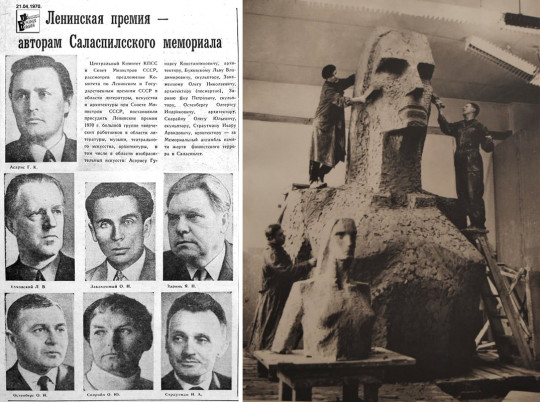
Left: a newspaper announces the Lenin Award given to the Salaspils design team. Right: ‘The Mother’ under construction.

‘The Unbroken,’ under construction, and then completed.
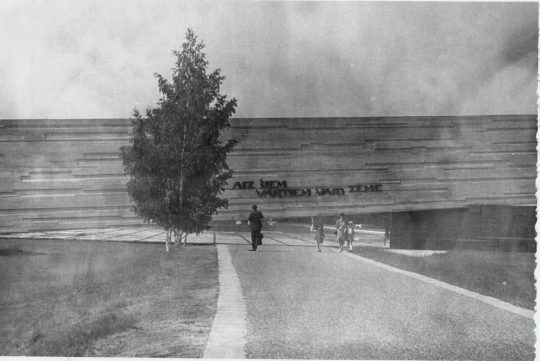
The gate to the Salaspils Memorial (late 1960s).
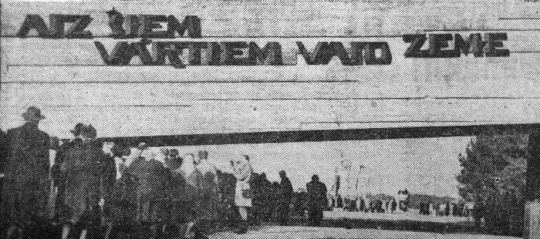
Visitors queue to enter (late 1960s).
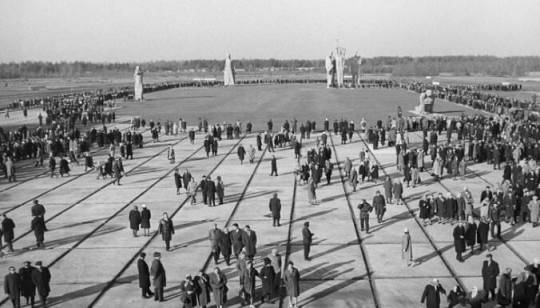
The memorial plaza at Salaspils (1968).

Left: Salaspils in 1975. Right: Cover of the 1985 Salaspils brochure.

The Salaspils Memorial Ensemble in 1970.
–
by Darmon Richter
[adapted with permission from an article at Ex Utopia]
245 notes
·
View notes
Text
His Last Bow
Originally titled in full "His Last Bow. The War Service of Sherlock Holmes" and later "His Last Bow: An Epilogue of Sherlock Holmes", this was originally published in 1917.
It is the final story in His Last Bow, the final short story in the canon covered by Letters from Watson and agreed by all the key chronologists to be the final canon appearance of Holmes and Watson.
Sir Arthur Conan Doyle had openly supported British entry into the First World War in 1914.
The story came about after a visit to the Western Front in 1916; asked by a French general what Holmes was doing, Doyle had responded that he was too old to serve. He then decided to write this story as a means of boosting morale.
To put it mildly, the British public had gone a bit spy-crazy in the lead up to the war; fearing "Teutons serving them croutons" i.e. Germans living in the UK acting as intelligence agents for the Kaiser.
The Riddle of the Sands is one such work of popular literature on this theme, which is the subject of Letters from Carruthers coming in September.
There was also the fantastical works of William Le Queux, who started off with the French and Russians as his enemies before switching to the Germans; he also had his works serialised in the Daily Mail, a British middle-market tabloid that was founded in 1896 and has been happily engaging in right-wing sensationalism since to the point Wikipedia has banned them as a source. Le Queux for his part believed the Germans were out to get him for exposing their spy networks - he hadn't, they weren't and the Metropolitan Police refused him protection.
The Benz company had produced the first practical motor car in 1885; they of course later merged with Daimler to become Mercedez-Benz. I cannot find a 100hp example of their vehicles.
The German Chancellor in 1914, Theobald von Bethmann Hollweg, was a moderate, who reluctantly went along with many German policies like unrestricted submarine warfare and tried to initiate peace proposals on a number of occasions in the war before being ousted in 1917.
Flushing is the historical English name for the Dutch port of Vlissingen; it had a ferry connection to Sheerness until 1994.
At the outbreak of war, diplomats on both sides were allowed to return home unmolested, after locking down their embassies and burning anything sensitive they could not take with them.
Britain, France and Prussia had signed a treaty in 1839 guaranteeing the neutrality and independence of Belgium. The German invasion of the country on 3 August gave the UK justification for war and moved a Cabinet divided over the matter to firm unity.
There was a fear of Irish civil war at this point; the Liberal government, reliant on Irish and Labour support for a Commons majority after the two elections of 1910, had passed legislation creating a devolved government for the island, called Home Rule. This was vehemently opposed by Ulster Protestants and both sides were receiving weapons - from Germany in fact - in preparation for a fight as Whitehall tried to arrange a compromise. The Germans in fact believed the British would be distracted by a civil war, but in fact the Home Rule legislation was suspended for the duration and both militias decided to support the war effort. That stopped things... until the more radicial Irish Republic Brotherhood launched the Easter Rising of 1916.
"Window-breaking Furies" refers to the suffragette movement that sort votes for women, some of who engaged in direct action like breaking windows and also planting bombs or arson, although they made sure the latter was done when the buildings were empty to avoid killing anyone. These tactics were as controversial at the time as the tactics of modern-day groups like Just Stop Oil. When the war broke out, the suffragettes stopped their militant actions and supported the war effort; their imprisoned members being released as part of an amnesty.
John Bull is a national personification of the UK, typically a stout middle-aged man in a Union Jack waistcoast, frequently seen in cartoons at this time. He rather fell out of popular use post-war and is rarely seen today, unlike Britannia, who remains a widely used figure.
The Rosyth Dockyard was built from 1909 for refitting Royal Navy ships and submarines; although now privatised, it retains that role and is currently building the five Type 31 frigates.
Carlton Terrace was the home of the German Embassy until 1945; after the war, the property and its contents were sold off at auction. The Federal Republic of Germany set up at Belgrave Square in 1951 and remains there to this day.
Junkers were the land-owning aristocracy of Prussia, who exercised considerable political power up until 1945, at which point most of their holdings ended up in the USSR, Poland or what became East Germany. The land was broken up, usually ending up in collective farms; accused of war crimes, those Junkers who ended up in Soviet hands frequently ended up in NKVD camps or even executed. Their descendants did not get them back after reunification.
The King's English is another name for Received Pronunciation, the "standard" dialect and accent of British English.
Tokay or Tokaji is a sweet wine from the Tokaj regions of Hungary and Slovakia, the designation being protected under EU law in a similar way to Champagne. Imperial Tokay, which was the highest quality Tokaji Essencia, was reserved for the Austrian imperial cellars, often being passed to other European monarchs as gifts. This stuff is still drinkable after over 200 years and even the relatively new stuff isn't cheap.
A naval flotilla would be based at Harwich in both World Wars.
The reference to Holmes being sixty here is where the common estimate of 1854 being his birth year comes from.
Portland is a prison and young offenders' institution in Dorset. Notable past inmates include George Edalji (whose miscarriage of justice was exposed by Doyle), John Babbacombe Lee ("The Man They Couldn't Hang") and the controversial comedian Roy "Chubby" Brown.
Fratton is an area of Portsmouth.
In reality, the Home Section of the Secret Service Bureau, later MI5, had managed to identify the key German agents by monitoring their postal correspondence. The police then rounded them up in August 1914 and once the cross-sea cables were cut, contact with any agents in the UK became close to impossible. Little intelligence of any use came from them in any event; the Germans seem to have not even been aware of the British Expeditionary Force being sent to France, which was hardly a small event. Gustav Steinhauer, head of German naval intelligence's British section, got subjected to a rant about his agency's incompetence from the Kaiser that lasted the better part of two hours.
Twelve German spies would be executed during the war, eleven by firing squad at the Tower of London, which hosted its final execution (also of a spy) in 1941.
Skibbareen is a town in County Cork, now in Ireland.
The final speech by Holmes at the end also featured in the 1942 Basil Rathbone film Sherlock Holmes and the Voice of Terror, based on this story.
So Holmes and Watson drive off into the sunset. What happened to them after that? All we know is that both survived the war and at some point Dr Watson stopped writing about his dear friend. They deserve to have had a long retirement.
I will be doing these for the individual chapters of the novels next year; I have already done ones for the first two chapters of A Study in Scarlet that I will repost.
44 notes
·
View notes
Text
Who Were The People Calling for Rudolf Hess's Release from Spandau Prison?

Having been found guilty of charges one and two of the indictment at the Nuremberg Trials, Rudolf Hess was sentenced to imprisonment for life. As we all know, Hess was doomed to die in prison, and had succumb to death on his own terms by committing suicide at the age of 93 on the 17th of August 1987. You may think that the idea of freeing Hess wasn't a particularly popular one, and that those who were in favour of it were most certainly Neo-Nazis. Well, this wasn't completely the case. In fact, many supporters of freedom were anti-nazi, and believed in freeing him on grounds of compassion. This post will explore support for Rudolf Hess's release through the years until his death.
In order for Hess to be released from prison, all four allied nations (UK, US, France and USSR) had to agree. The Soviets were the only nation opposed to freeing Hess.
The British government had supported the release of Rudolf Hess as early as 1956. In total, the UK made 11 unilateral attempts (along with 9 more from the French and US governments) to have Hess released from prison, however, the Soviets refused to budge in their belief that Hess should die in prison.
Pleas for his release on humanitarian grounds were made by UK politicians from the Conservative and Labour Parties. An appeal was also drafted in the name of Margaret Thatcher. The following read:
“There is to my mind no justification for keeping Hess in prison any longer. He is 88. He has been in prison for 40 years. He has been without the company of other prisoners for over 16 years. Humanitarian reasons demand that no one should be treated this way.”
Debates were also made in the House of Lords regarding the imprisonment of Rudolf Hess. A quote from Hansard on the 9th of February 1967 from Lord Robertson of Oak-Ridge said:
“Twenty one years have passed and all the others have gone. They have died or have been released on completion of their sentences. He alone remains, feebleminded, useless, dangerous to nobody. He is kept there still. It is pointless; it is inhumane.”
Support for his release even grew in the German government. In 1986, former German Chancellor, Helmut Kohl, addressed and sent letters to Ronald Reagan, Francois Mitterand, Margaret Thatcher and Mikhail Gorbachev (the respective leaders of the allied nations) , in which he wrote:
“I urgently appeal to you to mercifully release the prisoner into the bosom of his family. I believe that a pardon for Rudolf Hess is a dictate of humanity.”
His lawyer, Dr. Alfred Seidl was making appeals for his release as early as 1947, but these were always vetoed.
Outside of government, support for Hess's release was growing, and that was in the form of the Freedom for Rudolf Hess movement, a campaign that had begun in 1967 (not long after the release of Albert Speer and Baldur von Schirach) by Hess's son, Wolf Rüdiger. He started a petition calling for the release of his father. It had started at 700 signatures, but by 1974 had reached 350,000. In the book The Loneliest Man in the World, Eugene Bird claims to Hess that including those that signed this petition were lawyers, judges and even Nobel Prize Winners. He also tells Hess that there had been a movement set up in the US Congress to have him freed.


A little side note to this: Karl Dönitz had in fact attended one of the Freedom for Rudolf Hess meetings. As shown here. These images were taken in 1975. Hess's son, Wolf, is in picture number 2 (Taken from an old blog @/eternalvonschirach).
These calls to have Hess released would however fall on deaf ears. The Soviets insisted on him dying in prison. Their justification was that Hess was still an unrepentant Nazi, a man who still believed in his innocence. They were still unforgiving for the flight to Britain, in which they were firm in their belief that Hess wanted peace with Britain so Germany would not have to face a two front war.
And so Hess would die alone in prison, as the 'loneliest man in the world'.
30 notes
·
View notes
Text
Mim's Lament
by J.R.R. Tolkien
(This translation from the German translation, Mim's Klage, is the combined work of various online AI translators and my almost non-existent German, so please feel free to suggest amendments.)
Beneath a mountain, in an impassable land,
lay a deep cave filled with sand.
One evening Mim stood in front of his cave:
his back was hunched and his beard was grey;
long paths he had wandered, homeless and cold,
the little dwarf Mim, two hundred years old.
All that he forged, the work of his hand,
with burin and chisel, in toil without end,
had been stolen by fiends; and only his life and a few things
of the craft remained to him, and a long poisoned blade
in a scabbard under his tattered cloak.
His clouded eyes blinked, still red from the smoke;
For, clogged with thorns and heather, they at last
had cruelly set fire to his passages,
and so he emerged, choking and almost spewing.
Mim spat in the sand, and then began to speak:
Tink-tink-tink, tink-tonk, tonk-tonk, tink!
No time to eat, no time to drink, tonk, tink!
Tink-tonk, no time, tonk-tonk, no time to stay!
No time to sleep! No night and no day, and only hurry!
Only silver and gold, hammered and bent to shape,
and small, hard stones, glittering and cold.
Tink-tink, green and yellow, tink-tink, blue and white:
Under my hands sprouted and grew softly
long leaves and flowers, and red eyes glowed
In beasts and birds among the branches and blossoms.
All the things my eyes had seen, when they were still clear, when I was still young and the world was still kind. How I laboured to make them more enduring than memory! And they sprang from my heart, they curved under my hands, they bent and twined into strange and beautiful shapes - always alive and changing, and yet always rooted in my memory of the world and in my love for it. Then one day I stopped for a while and raised my head, and my hands rested on the stone workbench. I looked at my work. For it had grown out of Mim, but it was no longer Mim, and I marvelled at it. Jewels I saw, shining in the light of my little forge fire, and now they lay in my brown hand, which was old but still skilled and nimble. And I thought: Mim was very clever. Mim worked very hard. Mim had a fire in him, hotter than the forge. But Mim let it flow almost entirely into these things. They are a piece of Mim, because without them there wouldn't be much left of him.
So I thought of a good way to keep them, like things in a store, so that the clever memory could find them again. For everywhere they lay on the floor or piled up in the corners, and some hung on pegs from the walls, like the pages of an old book with dwarf stories, which time had eaten away and the winds had ravaged.
Clip-clop-clap! Clang-clang, tam-tam-tap! Tack-tack! Bring on the wood and bones, don't waste any time. Begin the work. Hew, saw, chisel, carve, hammer, nail. No time to rest. So I made my great chest, fitted with compartments and secret drawers. Dragon guards stared from the lid, entwined and writhing up from their taloned claws. The hinges rested between their sharp teeth. Old dwarves with axes stood beside the mighty clasp. Clap-clap, tink-tonk, the key was forged and bound by magic. Well! the big lid fell closed and so did my tired eyes. Long I slept, resting my head on my treasure chest, my hoard of memories and bygone years.
Did I sleep long? I don't know how much time passed. The forge fire had gone out, but choking smoke startled me. People came and stole everything I owned: the ore I had dug out of the rocks long ago, the heaps of precious stones, and they carried away my chest. They smoked me out like a rat, and in mock pity they let me run like a wild beast, through burning thorns and heath all around my deep home. They laughed as I stepped in hot ashes, and the wind carried away my curses. My reddened eyes discerned no path, and all I could save was a sack of small tools and, beneath an old tattered cloak, in its black scabbard my hidden knife with the poison runes on its blade. Often I sharpened it, spat on the scabbard until it shone under the cruel stars in desolate places.
So they took from Mim all his memories and all the joyful leaps and turns of his mind, to make gems for their sword hilt, rings for their greedy fingers and moons and stars and artless jewellery for the breasts of haughty women. They bartered them for little kingdoms and deceitful friendships, they murdered for them and darkened the gold with the blood of kinsmen. There is a fire in the memories of the ancient dwarves, and a power emanates from their fine hands that drives men mad, even if they are unaware of it.
But now I am old and bitter, and in my refuge in the wild mountains I must start the work all over again, try to catch the echoes of my memories before they fade away completely. Ah, still my work is good; but it is surrounded by hauntings. It lacks freshness, a veil lies between me and the things I see and create, as if shapes and lights had been swept up in a mist of tears. I glimpse what I used to create, but not that which I once saw. Dangerous am I, they say, full of hate and insidiousness, Old Mim, the little dwarf. If they touch me, I bite with black teeth or stab in the dark, and nothing can heal the wound of my knife. They dare not come near me, but from a distance they shoot arrows at me when I venture forth to gaze at the sun. It was not so before, and it is not well that it is so now. The course of the world becomes twisted and doubtful, treachery goes about, things creep up out of dark places, and under my fingers there grows fear and not delight. If only I could forgive, then perhaps I would still manage to form a leaf, a blossom with dew on it, just as it once shone on the Tarn Aeluin when I was young and felt for the first time how dexterous my fingers were. But Mim cannot forgive. Still the embers smoulder in his heart. Tink-tonk, tonk-tink! No time to think!
- -
Brewing Books made a video about their translation of the verses.
62 notes
·
View notes
Text
Erich Hartmann (1922 - 1993)
The most successful fighter pilot in history. In the span of 3 years, Erich "Bubi" Hartmann shot down 352 enemy aircraft.

Erich spend a part of his childhood in China, when things got too politically dangerous, his family moved back to Germany. His mother was one of the first women to pursue flying on glider planes and she often took Erich with him, igniting his love for flying.
After graduating school in 1940, he immediately joined the Luftwaffe and started training as a fighter pilot. In October 1942 he was sent to the Eastern Front, joining the war. Young and impulsive as he was, he didn´t stick to the rules at his first enemy encounter, resulting in a crashed plane. He was assigned as Rottenflieger of Walter Krupinski, another young but already experienced and successful fighter pilot who managed to teach Erich that working as a team is crucial for success and survival.
Within a year he shot down 90 victories, before being shot down himself, but managing to escape Soviet imprisonment.
Im March 1944 he shot down his 200th victory, by August his 300th.
In late 1944 he was pulled from the Eastern Front to train on the revolutionary new jet fighter Me-262, but in March 1945 he returned to his Geschwader. He declined Adolf Gallands offer to joing JV 44.
On the day of the capitulation, 8th May 1945, he shot down his final victory, number 352.
He had the chance to espace to southern Germany but he refused to leave his comrades and the fleeing civilians behind. They started towards the German border on foot and surrendered themselves to US soldiers, but where handed over to the Russians. [There is an interesting comparison to Hans Ulrich Rudel (the most successful Stuka pilot) who also surrendered to Americans who were also supposed to hand him over to the Soviets but refused.]
Erich Hartmann, just 23 years old at the time, was sentenced to 20 years of hard labour under the accusation of war crimes (these "crimes" entailing destroying russian airplanes).
Not being allowed a proper trial, there was little he could do to defend himself. He was shifted around to several labour camps (gulags).
During the endless interogations, the Russians tried to get all information about the Me-262, but Hartmann didn´t cooperate. In order to break him, they tried to extort him by not giving him the letters his wife, Ursula, wrote him. She faithfully wrote him everyday. In one of those letters, Hartmann learned that his son had died.
But he did not break and he never lost hope.
After more than 10 years, Erich Hartmann was one of the last PoWs to return to Germany, to his wife.
He joined the Luftwaffe in 1956, not because he truly wanted to but because he felt like he had no other option. Erich had always wanted to become a doctor like his brother but all he knew was being a soldier, a pilot.

After his death he was cleared of all war crime accussations.
9 notes
·
View notes
Text

Pre-election rally in Hamburg, 1932, organised by the NSBO (Nationalsozialistische Betriebszellenorganisation/National Socialist Factory Cell Organisation). The NSBO was formed in 1928 but was superceeded by the DAF (Deutsche Arbeitsfront/German Labour Front) in 1933 and then completely absorbed in 1935. Note NSBO banner on upper right and the party newspaper banner upper left
#germany#ww2#nazi germany#nazi party#nsbo#daf#german labour front#deutsche arbeitsfront#Nationalsozialistische Betriebszellenorganisation#National Socialist Factory Cell Organization#hamburg
3 notes
·
View notes
Text


Without doubt Friedrich Wilhelm Kraemer (1907-90) was one of postwar Germany's most successful architects: his office Kraemer, Sieverts & Pfenning (later Kraemer, Sieverts & Partner) for almost four decades decidedly influenced the architecture of the Federal Republic with high-profile buildings like the Jahrhunderthalle in Frankfurt/Main, numerous bank and insurance buildings as well as other industrial and cultural buildings. Influenced by prewar International Style and the example of Mies van der Rohe Kraemer gave the young German democracy an international Concurrently Kraemer as professor at Technical University Braunschweig together with fellow with fellow professors Walter Henn and Dieter Oesterlen established what came to be coined “Braunschweiger Schule”.
Over time Kraemer idiom changed quite significantly and in later years became much more sculptural and brutalist, an indication of his moving with the times. In 2007 the publication "Gesetz und Freiheit - Der Architekt Friedrich Wilhelm Kraemer" was published by Jovis Verlag alongside the eponymous exhibition at Braunschweigisches Landesmuseum and documents Kraemer's built and theoretical work as well as his teaching. Beyond topics like Kraemer’s early postwar educational journey to Chicago with students of TU Braunschweig the authors also don’t omit Kraemer’s high ranking position during the Nazi era: Kraemer served as architect of trust for the “Deutsche Arbeitsfront”, the German Labour Front, the regime’s single most largest organization, and in this capacity built for industrial enterprises and arms factories. Among these buildings also were forced labour camps.
Through its broad approach the book provides interesting insights into the life and work of a very busy postwar architect: his design process, his influence as professor and his long-term relationship with architectural photographer Heinrich Heidersberger are equally addressed and draw a comprehensive picture of Kraemer the architect and human being.
#friedrich wilhelm kraemer#monograph#architecture#germany#nachkriegsarchitektur#nachkriegsmoderne#architecture book#book
20 notes
·
View notes
Text
Labour IV
꧁ ꧂
Labour Masterlist
꧁ ꧂
Charles Xavier x OC
꧁ ꧂
"Afternoon, gentlemen." Erik put his hat and coat on the rack of the door. "Hot out there."
He walked to the bar and sat down. "Beer, please." The bartender filled a glass and set in down in front of Erik and leaned forward on the tabletop. "German beer. Of course."
"Yes, it's bitburger. You like it?" A man behind him spoke laughing at the end.
"The best." Erik answer scoffing out a laugh. Erik turns around to ask the two men at the table behind him. "What brings you to Argentina?"
"The climate. I'm a pig farmer." The man who spoke before answer, laughing again. Erik smiled.
"Tailor. Since I was a boy. My father made the finest suits in Dusseldorf." The other man spoke, he had a cigarette in his right hand.
"My parents were from Dusseldorf!" Erik got off the stool and sat by the pig farmer.
"What was their name?" The tailor asked.
Sitting down Erik answered, "They didn't have a name." The two men looked at each other in uncertainty. "It was taken away from them," he hit his glass to the pig farmers. "by pig farmers," he leaned forwards and hit his glass on the tailors "and tailors."
All of them drank the two men looked nervously while Erik was practically grinning ear to ear. They all placed their glasses down in the table and Erik slowly turns his arm to show his tattoo.
The pig farmer quickly grabbed a knife in his belt and went to stab Erik. He stopped it by grabbing the pig farmers wrist and pinning it down on the table, ripping the knife from his hands he read what was carved on it.
"Blood and honor. Which would you care to shed first?"
"We were under orders."
"Blood then." Erik raised the knife and pierced the pig farmers hand. The tailor quickly stood up and the bartender aimed a gun at Erik.
"Freeze, asshole." Erik pushed the gun to point at the tailor and forced the gun to shoot.
Taking the knife out of the pig farmers hand he threw it at the bartender and pulled it back and reinserted it into the man's hand.
Brushing his hair back he downed the rest of his drink. While he was drinking the pig farmer questioned him.
"Who, what are you?" He whined out in pain. Erik placed the glass back down.
"Let's just say I'm Frankenstein's monster." He stood up and walked over the picture on the wall with the two men and Schmidt.
"And I'm looking for my creator." The gun floated out of the dead bartender's hand and Erik grabbed it pointing it the pig farmer and shooting.
꧁ ꧂
"Still drinking champagne Bob?" Shaw stepped behind the bar.
"I will pass." Hendry stepped a few feet away from the front of the bar.
"Okay, well, so much for the pleasantries." He bent forwards leaning his forearms on the bar top. "I was wondering who you told about our little arrangement." He took a breath from his cigar.
"No one." Shaw looked over to Frost.
"He's telling the truth." She confirmed his statement, laying on the sun lounger. Atara was next to her she was talking to Riptide who was sitting on the steps until the colonel showed up then he stood up waiting in front of Atara's sun lounger.
"Good, we'll I guess we're done here. Let's wrap things up, shall we?" Riptide stepped forwards until the colonel pulled out a grenade.
"Oh, I knew better than to trust you." He started stepping back. "Now, you let me walk out of here with my money, or I will pull this pin, and we all die."
"Go ahead, pull it." Shaw egged him on.
"I'll do it, I swear to god." Hendry put his hand on the pin.
Atara teleported beside the colonel and grabbed his hands. "No, you won't." She grabbed it and took it away. Pulling the pin and pushing off the lever she tossed it to Shaw.
It exploded and Shaw contained it by sprouting many arms and absorbing the energy. Hendry looked at him in horror.
"You're one of them?" Hendry stepped back.
"Very astute of you, colonel Hendry. You want to guess what I can do? I've got the power to absorb energy. It keeps me young. But that's the boring part. The fun stuff is what I can do with it once I've got it." Shaw reached out and tapped the colonel's chest and light surrounded him, and he evaporated.
꧁ ꧂
759 words
2 notes
·
View notes
Text
Concerning the long-term implications of AI “art”, it may be that things will develop into the same direction in which they went in a different creative field that has already been transformed by AI, which is translation. Now, everyone who isn’t a complete idiot knows that you can’t feed your website or book to Google Translate and expect a great translation. You need human eyes to make sure the robot hasn’t confused turkey the bird and Turkey the country again, though admittedly newer translation systems are getting better at that. But what is pretty standard in translation today is a set-up in which an AI translates and a human proofreads. That’s much faster and it uses the strengths of AI (speed, price) and humans (accuracy, common sense).
It also fucking sucks for the human.
I used to work as a freelance translator. I cannot begin to describe how absolutely mind-numbingly boring it is to proofread machine translations. Everything that makes translation fun and a labour of love gets obliterated.
See, when I want to translate something, no matter whether it’s for money or for free (which I still love doing), I usually read some paragraphs first that are written in the style I’m going for and in the language I’m translating into. For pro jobs that was generally German because you generally translate into your native language(s) exclusively, but I was also sometimes hired to translate into English. It’s important to get into the right frame of mind, activate the right style of language in your brain. Once you delve into the text, it becomes a self-sustaining momentum since your own output constantly re-trains you to stay in the same style.
But that also means that when you proofread bad prose for hours, your style becomes consistently worse. You eventually start to think the same way as the text you have in front of you. If the style is inconsistent, if there are often words that... you know, aren’t completely wrong but have the wrong connotations, if the style is just not great, then your style won’t be great either. And you will know, but you can’t really change it, at least not without constantly “re-setting” yourself by taking a break and reading something written by a good human writer, which is time-intense and no one’s gonna pay you for that. It happened to me sometimes that I read the translation first and then didn’t understand the original anymore because the translation was such a word salad. When I have translated a difficult and complex text on a topic I understand well, I feel accomplished and energized. When I have proofread bad prose on the same topic, I feel exhausted and annoyed.
Proofreading machine translations is a slog. It’s not fun, it doesn’t produce especially good output - it does produce ok output quickly and cheaply, which is usually all that the customer wants, but at the cost of the translator’s misery. Unfortunately, I can see the same thing happen to professional illustrators. They might routinely get some AI output and be told to “fix it”, make the faces in the picture not look like potato salad, paint over watermarks (lol). Which will be cheap, and convenient, and make artists miserable the same way machine translation is making translators miserable. Because there’s no creativity involved, no sense of creation, you just clean up after the machine, knowing full well that the output is mediocre at best. The dominant system seems to transform every line of work into a sweatshop somehow...
14 notes
·
View notes
Photo

On this day, 20 January 1934, Nazi Germany introduced a decree "regulating national labour" which according to the US government "introduced the fuhrer-principle into industrial relations". The owner was deemed the fuhrer of an enterprise, who was responsible for making all "decisions for the employees and labourers in all matters concerning the enterprise"… "The employees and labourers owe him faithfulness". Robert Ley, head of the German Labour Front, which was set up by the state after all trade unions were banned, told a meeting of Siemens workers in Berlin, some of whom were enslaved labourers: "We are all soldiers of labour, amongst whom some command and the others obey. Obedience and responsibility have to count amongst us again... We can't all be on the captain's bridge, because then there would be nobody to raise the sails and pull the ropes. No, we can't all do that, we've got to grasp the fact." Along with other measures against radical workers, Nazi policies led Ley to declare in 1935 that Germany was the first European country to end the class struggle. They also helped reduce the share of national income going to workers: which fell from 56.9% in 1932 to 53.6% in 1938, while the share going to big business soared from 17.4% up to 26.6%. Pictured: Nazis raiding a union office. Learn more about German resistance to nazism in our podcast episodes 63-64: https://workingclasshistory.com/podcast/e63-64-mildred-fish-harnack/ https://www.facebook.com/workingclasshistory/photos/a.296224173896073/2190738331111305/?type=3
155 notes
·
View notes
Text
German Media Realise Their Health Minister is an International Laughingstock
The Covid Inquiry is Insulting the Victims of Lockdown
Boris Johnson is Still in Denial About Lockdowns
Bristol University Axes the National Anthem from Graduation Ceremonies Amid Students’ Claims it is “Old-Fashioned” and “Offensive to Some”
Labour Parliamentarians Back Kemi Badenoch on Stopping Children Changing Gender at School
U.K. Government’s Veto of Scotland’s Gender Reforms Ruled Lawful by Top Court
News Round-Up
German Media Realise Their Health Minister is an International Laughingstock
By Eugyppius
I know that some of you are impatient with my posts about German politics, and particularly my repeated pieces on our retarded Health Minister. I get that this can seem like inside baseball, and that all of you suffer under the very similar idiocies of your own Covid politicians. But, I just can’t help myself. Lauterbach is a special case, a truly monumental idiot who in his boundless incompetence and stupidity vastly exceeds his peers. It is my aim to make him the international symbol of pandemic derangement. I want pictures of this human incarnation of everything that is wrong with masking children and force-vaccinating millions printed next to future dictionary entries on Covidianism. We have seen the enemy, and it is this sad, stupid, Smeagol-looking loser, who thinks Eric Feigl-Ding is an authority and that clip-on bowties are fashionable.
You must understand that Lauterbach is not only the dumbest federal politician Germany has ever had. He also ranks among the least competent, most bafflingly idiotic people ever to have attained prominence of any kind. He is a drunken tweeter who as Cabinet Minister once declared war on Russia. He is a dim salt-phobic eccentric whose own ex-wife declared him unfit for the responsibilities of a Cabinet position. He is a tireless advocate of mask mandates who in May 2021 was photographed totally maskless on a train to Hamburg.
He has written one of the saddest, most derivative and pointless Ph.D. dissertations I have ever read. He poses as an epidemiologist while routinely misinterpreting even the simplest scientific studies. His most memorable science fail was a tweet citing a “new American Mega [sic!] Study” showing that mask efficacy is “very great and uncontested”. His link led to a bizarre pre-print that was so bad, some concluded it had to be a hoax. When a serology study emerged showing that 95% of Germans had Covid antibodies, he denied the results meant the pandemic was over, inadvertently questioning the entire premise of mass vaccination. He spent much of early 2022 demanding that ever more people get fourth doses and even said he himself was quadruple vaccinated. Three months later he announced he had tested positive for Covid, declared his symptoms to be substantial, and then violated Berlin quarantine rules to attend a press conference, where he was stupid enough to flash his digital vaccine pass to the cameras. The QR code revealed that he had only ever received three jabs. His Ministry insisted he’d merely failed to register his second booster with the CoronaWarn app, but the next year he doubled down on his stupidity, allowing the press to photograph his physical vaccine records, showing only three doses were registered there as well.
At one point he proposed to exempt the recently vaccinated from indoor mask rules, saying that he hoped this would encourage further vaccine uptake. After polls showed that disturbingly large numbers of Germans were willing to accept quarterly vaccination for the privilege of mask exemptions, he said he’d withdraw the incentive if too many people took advantage of it. This summer, with the political relevance of Covid fading, he opened a new front against summer weather, announcing an initiative to call old people and remind them to drink water whenever temperatures get too high.
There has been such an unrelenting tidal wave of Lauterbachian moronicity that it has proven impossible to keep track of it all. He is an endless source of comedic content, a political lolcow who stumbles from embarrassing gaffe to embarrassing gaffe without ever seeming to notice. Last year, he appeared on national television and ranted bizarrely about the Stanford epidemiologist John Ioannidis and the Great Barrington Declaration. He seemed to be drunk, or perhaps under the influence of some medication, as he mashed his words about “certain scientists who are shared exponentially on social media”:
So there is exponential growth in viruses, and there is also an exponential growth in false information. You only need a few scientists for this… In the case of Corona, for example, there was a scientists who used to do very good work but has now drifted off course. A Stanford scientist, Ioannidis, made a declaration, the Great Barrington Declaration, which basically said that the virus is not that dangerous, that it’s not killing people, that flu can be more dangerous and so on, a lot of things that just aren’t right. And this has been quoted incredibly often by these people, who are out there, and there are just far too many of them, who would like to hear the relieving message, “it’s not really that bad, we don’t have to do anything”.
The rant escaped notice at the time, but was recently unearthed by my Twitter friend @tomdabassman, who uploaded the clip with English subtitles. He tagged Stanford medical professor and Great Barrington Declaration co-author Jay Bhattacharya, who could hardly believe his eyes. Almost everything in Lauterbach’s rant was wrong, and he said so in a tweet that has now been viewed almost a million times:
Now, for better or worse, Germany looks up to America and prizes American academic culture. When a Stanford professor criticises the German Health Minister, the German press take notice.
First was a modest article in the Berlinzer Zeitung – ‘Harsh criticism from abroad: “Lauterbach seems not have any inkling”‘
Stanford Professor Jay Bhattacharya doesn’t see [Lauterbach’s statements] as a laughing matter. He wrote on Monday that he’s sorry the Germans had such an unqualified health minister during the Covid pandemic.
He countered Lauterbach’s statements with four points: firstly, Professor John Ioannidis is far from being an outmoded scholar and is one of the most frequently published and cited scientists on the subject of Covid. Secondly, he neither wrote nor signed the Great Barrington Declaration. Thirdly, even this declaration did not declare the virus to be harmless …. Fourthly, Bhattacharya says that “Lauterbach seems to have no idea of the damage his lockdown policy has done to the poor, children and the working class. Germany has worse Covid results than neighboring Sweden”.
The original tweet with the Lauterbach video has already been viewed 500,000 times; the tweeting Health Minister has not yet responded publicly to the Stanford professor’s message.
Then came Bild, the largest-circulation newspaper in Germany, with the headline ‘Stanford Professor has harsh criticism for Lauterbach‘:
In his Covid policy, Karl Lauterbach repeatedly talks about science, arguing with studies and articles. But, of all people, a renowned Covid scientist is now sharply criticising the German Health Minister!
Stanford Professor Jayanta Bhattacharya (50), an expert in health economics, has accused Lauterbach on X of being “incredibly misinformed about Covid science”.
The reason for the outrage: an RBB interview with Lauterbach from March 12th 2022.
In an interview excerpt shared by Bhattacharya, Lauterbach complained about an “exponential growth not only in viruses, but also in false reports. … In the case of Corona, for example, there was a scientists who used to do very good work but has now drifted off course: a Stanford scientist, Ioannidis,” Lauterbach says. He is referring to John Ioannidis (58), Professor of Medicine and Professor of Epidemiology and Population Health at Stanford University.
Statements that Bhattacharya won’t let stand!
“Professor John Ioannidis is not ‘worn out’ and is one of the most published/cited scientists on Covid,” he says… Furthermore, Ioannidis neither wrote nor signed the ‘Great Barrington Declaration’. And the Stanford professor clarifies in his counterattack on Lauterbach that the ‘Great Barrington Declaration’ never claimed that the virus was “not dangerous.” … “Lauterbach seems to not have any inkling of the damage his lockdown policies did to the poor, to children, and to the working class,” says Bhattacharya. AND: The Stanford professor even calls Lauterbach “unqualified”.
Major blogs and online magazines like Reitschuster and Tichys Einblick have picked up the story, with headlines about how badly informed Bhattacharya finds Lauterbach to be. News.de calls Bhattacharya’s “public reprimand” a “bitter slap in the face” for the Health Minister; Der Westen says much the same, as does the television broadcaster ProSieben.
We desperately need more of this. I call upon Jay Bhattacharya to continue his attacks on the German Health Minister. He is a moronic pseudointellectual fraud and a menace, and the German people need to hear this from Stanford professors like him. Perhaps the other authors of the Great Barrington Declaration could add their voices too. Surely John Ioannidis would also like to weigh in.
This piece originally appeared on Eugyppius’s Substack newsletter. You can subscribe here.
COMMENTS
The Covid Inquiry is Insulting the Victims of Lockdown
By Will Jones
What gives the relatives of Covid victims the sole right to the moral high ground, asks Allison Pearson in the Telegraph. Lockdowns were devastating, and their victims were often far younger than those of Covid. Yet the Covid Inquiry puts the spotlight on the former while largely ignoring the latter. Here’s an excerpt.
I really must stop watching the Covid Inquiry, it’s bad for the blood pressure. Even the element of drama is lacking because we all know how this story ends: Lady Hallett, shaggy blonde bob shaking sorrowfully, will find that chaotic, ‘shopping-trolley’ Boris locked down too late (even though notably un-chaotic Germany only locked down two days earlier than us). Bad Boris also raised commonsense objections to lockdown and refused to keep the population masked and social distancing in perpetuity, as recommended by Susan ‘Stalin’s Nanny’ Michie of the SAGE scientific advisory group.
Given the choice between Boris’s hale-fellow magnanimity and Michie’s joyless authoritarianism, I know which I would choose, but that is very much not the preference of this appalling establishment sham.
Relatives of those who died from Covid are allowed to be present (holding up laminated photos of the deceased) which gives proceedings the feel of a tribunal in Revolutionary France hellbent on personal revenge rather than what they should be; a rational and honest assessment of whether shutting down the country was justified.
After the former Prime Minister apologised on Wednesday – “I understand the feelings of these victims and their families, and I am deeply sorry for the pain and the loss and the suffering,” said Boris – four protesters stood up, holding signs which said: “The dead can’t hear your apologies.”
What gives those people the right to sole occupancy of the moral high ground? Of course their losses are terribly sad, but the median age of death from Covid (about 83 years) was not that different to the normal life expectancy for men and women before the pandemic. What about younger people killed or traumatised by lockdown?
Where are the photos of the formerly happy girl who developed anorexia in 2020 and tragically took her own life (as recounted by the girl’s mother to a rightly upset Julia Hartley-Brewer on her Talk TV show)? How about the one million youngsters currently on a waiting list for mental-health services, a shocking queue that would stretch from London to Manchester?
Any portraits perchance at the Inquiry of the bereaved at funerals who were not allowed to console each other, not even when they lived in the same house for goodness sake? Or the pregnant women who went through miscarriages alone because, apparently, having the father with them was too much of a Covid risk?
How about the distraught, self-isolating spouses of confused and lonely care home residents who could not visit while staff trooped in gaily with their Tesco carrier bags? What about the grown men and women who still cry into their pillow at night fretting that their darling mum or dad died thinking they had abandoned them?
Worth reading in full.
COMMENTS
Boris Johnson is Still in Denial About Lockdowns
By Will Jones
When he appeared at the Covid Inquiry this week, former Prime Minister Boris Johnson had a golden opportunity to get to the heart of the issue and denounce lockdown as unnecessary and harmful. But he blew it, says Dr. Jay Bhattacharya in UnHerd. Here’s an excerpt.
As a vocal Covid dissident and lockdown opponent throughout the pandemic, watching the U.K. Covid Inquiry these past few weeks has been a depressing experience. One gets the sense that both the people leading the inquiry and the vast majority of those questioned — the architects of the U.K.’s disastrously failed Covid policy — have learnt nothing.
At one point on Wednesday, Boris Johnson had a golden opportunity to get to the heart of the problem. The lead inquiry lawyer, Hugo Keith KC, asked the former Prime Minister whether the late March 2020 order to lock down the country was “absolutely necessary”. This was Johnson’s golden opportunity to confess the cardinal error of the U.K.’s pandemic strategy: that it imposed lockdown in the first place.
Instead, he averred that the U.K. had “no other tool” than lockdown available. Under questioning about his involvement in pandemic decision-making in January and February 2020, the ex-PM’s mea culpa centred on his regret that he had not “twigged” the seriousness of the Covid threat earlier.
One major problem with this reasoning is that by the time February 2020 rolled around, Covid was almost certainly more widespread than anyone realised because it had arrived earlier than anyone realised. In 2019, Chinese authorities delayed reporting the existence of the virus to the world. Studies of antibodies in stored blood and stored wastewater from across the globe — including Italy, the U.S., Brazil and elsewhere — found traces of Covid’s presence in autumn 2019, long before the world knew about it. Even a January 2020 lockdown would have been too late: our fate was sealed once the virus was abroad in the world.
“The inquiry has been marked by a studied lack of curiosity about the great control group of the pandemic: Sweden,” Dr. Bhattacharya continues. “But Sweden did better than nearly every other country on earth in protecting human life. It has among the world’s lowest cumulative age-adjusted all-cause excess deaths since the start of the pandemic. And it accomplished this feat without lockdown.”
Worth reading in full.
For the full story on early Covid spread, see here and here.
COMMENTS
Bristol University Axes the National Anthem from Graduation Ceremonies Amid Students’ Claims it is “Old-Fashioned” and “Offensive to Some”
By Will Jones
Bristol University has axed the National Anthem from its graduation ceremonies with some students claiming it is “old-fashioned” and “offensive to some”. The Mail has the story.
The anthem has not been played since last year’s ceremony with the university saying it regularly updates its graduation ceremonies.
God Save The King will now only be played when a member of the Royal Family is present.
Some students at the 147-year-old university have suggested the National Anthem was culled because it is “irrelevant”, “old-fashioned” or might even be “offensive to some”.
It comes just weeks after the university vowed to remove slave trader Edward Colston’s emblem from its logo, after his statue was toppled during a Black Lives Matter protest in the city in June 2020.
Layla Daynes, 21, told the Sun: “The monarchy isn’t really relevant to my generation, so it wouldn’t be missed.”
Free Speech Union director Toby Young asked: “Why are Britain’s most prestigious universities openly contemptuous of the country’s history and heritage?”
Worth reading in full.
If the point of multiculturalism – which many of the university bosses who make these decisions would swear by – is that we are supposed to be united as a nation despite sometimes massive differences in cultural outlook, how is axing the National Anthem – a prominent symbol of our nation as one people that transcends our differences – supposed to help with that? The suspicion must be that decisions like this are motivated primarily by hatred of country and its history than any honourable motive. Sidelining the National Anthem makes little sense even for the adherents of the multicultural creed – unless the point is just to do Britain down for its supposed ‘systemic racism’ and historic ‘colonialism’.
COMMENTS
Labour Parliamentarians Back Kemi Badenoch on Stopping Children Changing Gender at School
By Will Jones
Tony Blair’s former Education Secretary Estelle Morris, who now sits in the Lords as a Labour peer, has backed Kemi Badenoch on trans rights by saying children should not be encouraged to change gender. The Telegraph has more.
Estelle Morris said pupils should be taught in biology lessons that there are only two sexes.
Speaking in a debate in the House of Lords, she warned that if teachers allowed children to “socially transition”, by referring to them by a different pronoun or name, it could cause them “psychological damage”.
She added that parents should always be informed if a child was struggling with their gender identity.
The comments go much further than the official Labour position, which so far has simply called on the Government to publish advice to schools on gender issues.
A group representing lesbian members of the Labour Party backed Equalities Minister Mrs Badenoch after she warned of an “epidemic” of gay children being told they were transgender.
The Lesbian Labour Group said: “How come a Tory minister can be right and Labour is so wrong?”
The Government has still not published long-awaited guidance for schools on how to deal with children who say they want to change gender, such as whether they should be allowed to take part in sports with children from the opposite biological sex.
I shudder to think what a Starmer-led Government will allow in our schools – it’s been bad enough under the Tories, whose ‘war on woke’ has often felt like little more than empty words from an administration powerless against the Blob.
Worth reading in full.
COMMENTS
U.K. Government’s Veto of Scotland’s Gender Reforms Ruled Lawful by Top Court
By Will Jones
Scotland’s highest court has ruled the U.K. Government acted lawfully by vetoing Nicola Sturgeon’s self-ID gender laws in a humiliating defeat for First Minister Humza Yousaf. The Telegraph has more.
The
2 notes
·
View notes